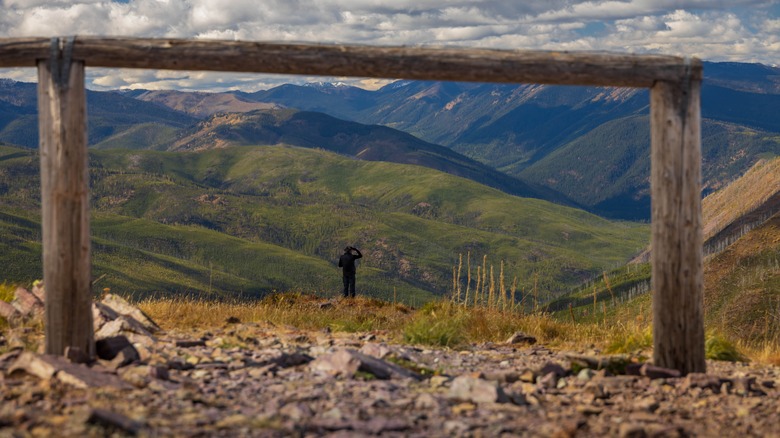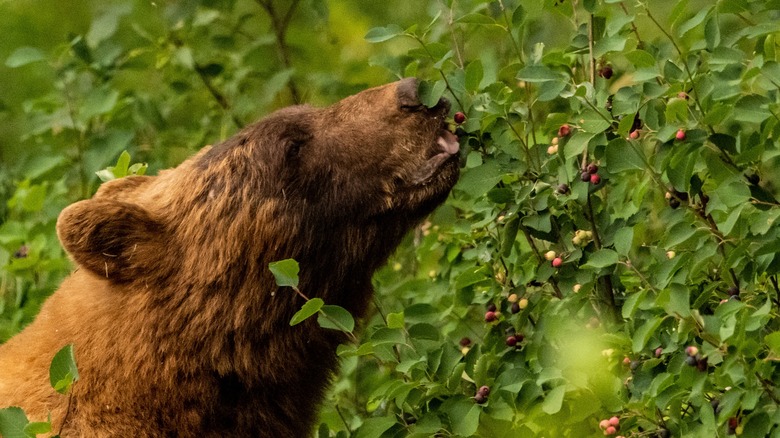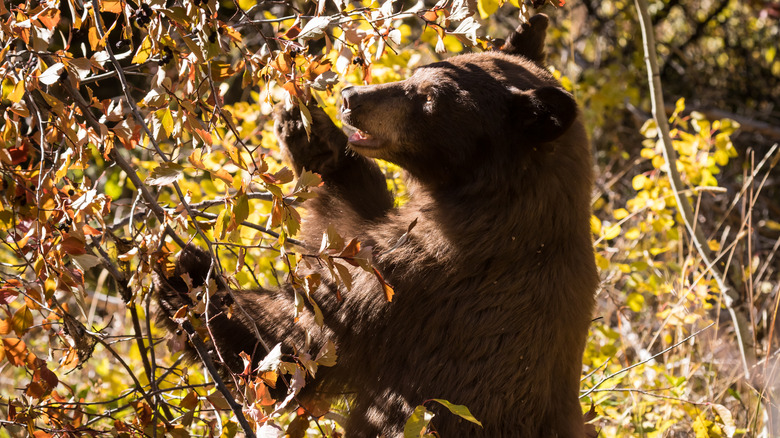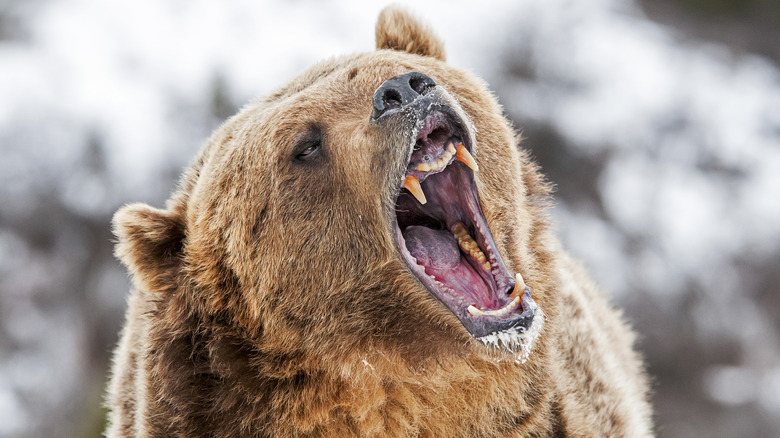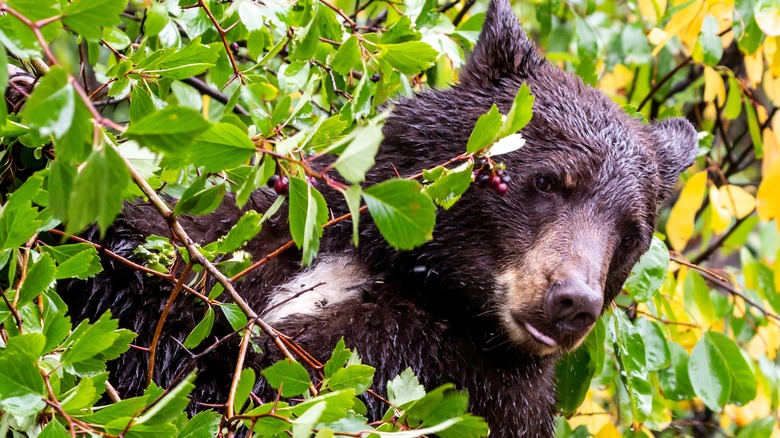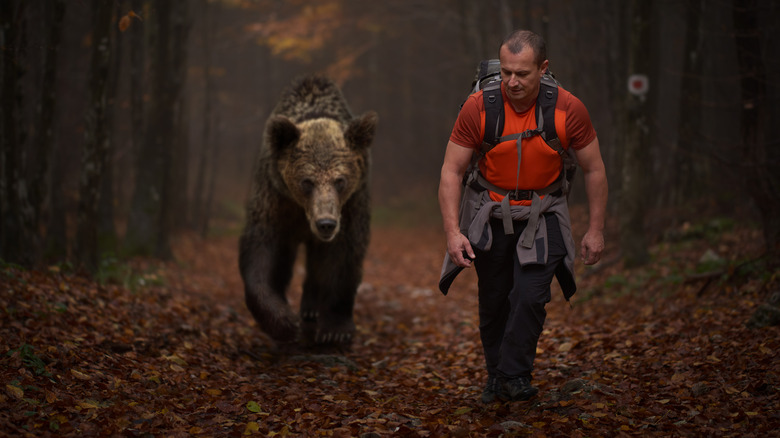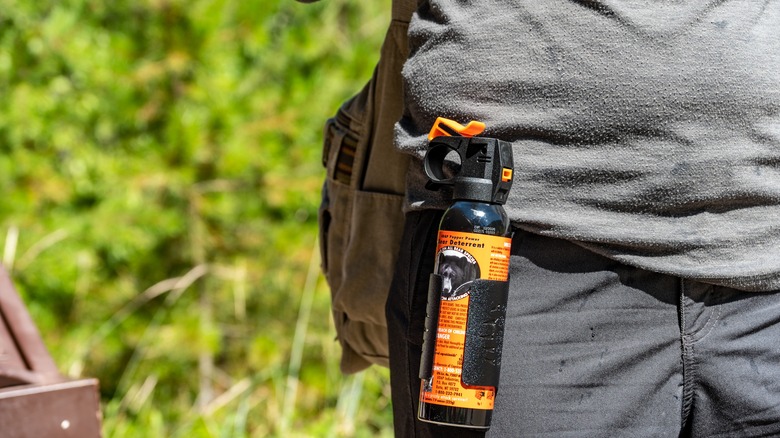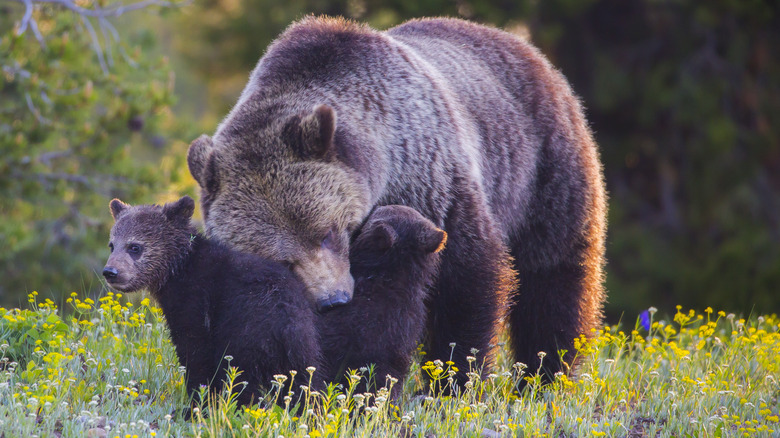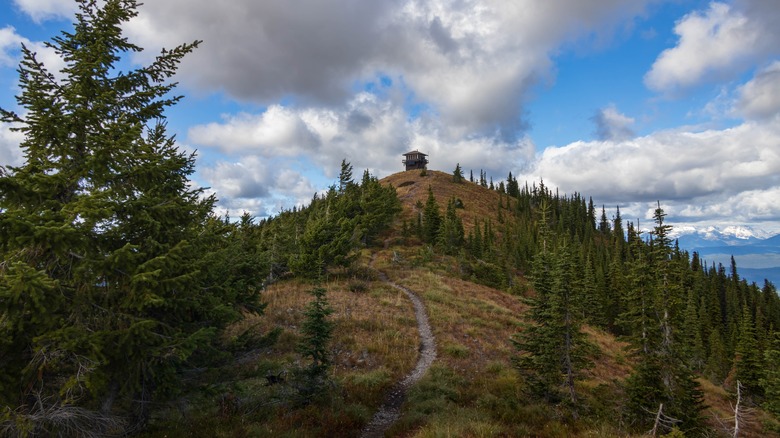Glacier National Park Closes This Trail For A Terrifying Reason
Is there any better way to spend the day than exploring the Great Outdoors? No. No, there is not. Going to a local park will certainly give anyone a much-needed pick-me-up, and the opportunity to venture into the wilderness of the country's incredible national parks is the experience of a lifetime. They give visitors a small glimpse into what the entire country looked like at one point, and it's a humbling experience.
Glacier National Park is one of the most famous national parks, and there's a good reason for that: It's incredible. Sprawling across a good portion of Montana, it's an opportunity for visitors to see some serious splendor — and that's not an exaggeration. There's also some neat Montana history that can be glimpsed along the trails, and that's the huckleberry. Wait, where is this going?
When it comes to beloved state foods, huckleberries are right up there for Montana. Huckleberry pie, huckleberry fudge, huckleberry jams, jellies, sauces and spreads, there's seemingly no end to the huckleberry delights. The entire commercial industry is worth millions, and that's partially because the growing conditions are perfect. Huckleberries love soil with a high volcanic ash content, and they also thrive in areas that have been devastated by wildfires. Time a visit to Glacier National Park — and the aptly-named Huckleberry Lookout Trail — just right, and pick your own ... but, there's a catch. The huckleberries that grow all along the trail necessitate regular closures, and for a very good reason.
Yes, it's bears
While it might seem like part of the fun of hiking Huckleberry Lookout Trail would be picking a handful of right-off-the-bush huckleberries to enjoy along the walk, trail closures often coincide with peak huckleberry season. That's from the middle of July to the middle of September, and although it seems like that's kind of a bummer, there's a very, very good reason for those closures. Glacier National Park supervisory ranger Gary Moss explained to Backpacker, "Large numbers of bears congregate there when there's a bumper crop."
Oh. Well, that's a pretty good reason then, right? Humans aren't the only ones who love those oh-so-delicious huckleberries, and according to research done by the National Park Service, it's estimated that the park's bears rely on Montana's beloved berry for as much as 15% of their diet. (Incidentally, the Huckleberry Lookout Trail presents such a good sampling of bears and berries that it's the site of research into how the success — or failure — of the year's huckleberry crop might impact bears' behavior.)
It's worth mentioning, too, that Glacier National Park isn't just home to a few bears: Although exact numbers are unknown, the NPS estimates there's somewhere around 1,000 bears living in the park. And Huckleberry Lookout Trail? Let's put it this way: It's kind of like setting up a free taco bar at a college during finals week.
Yes, encounters have happened
Sure, bears are adorable. Sure, they will always and unconditionally get a "10/10, Would Pet" ranking. But those cute floofballs come with not only massive claws but even bigger appetites — especially when they're getting ready for their annual, winter-long snooze, or just waking up from it. And yes, there have been incidents where hikers have run into bears along the trail.
In July of 2020, the National Park Service issued a warning bulletin that a woman who had been jogging along Huckleberry Lookout Trail had surprised a grizzly bear ... although, it's really up for debate on who was actually more surprised. She actually physically ran into the bear, and they fell off the trail in a heap that had to have been pretty terrifying. Thankfully, the bear ran off, but that hasn't always happened.
In 2016, a park employee was on the trail picking huckleberries when she had a run-in with a grizzly and walked away with severe but non-fatal injuries. The most devastating tragedy played out in 1998, when an ill-advised seasonal employee set out with the goal of getting up close and personal with the park's bears. Craig Dahl disappeared in May — amid warnings that very hungry bears were in the process of emerging from that aforementioned slumber — and his remains were discovered a few days later. Non-fatal bear attacks do happen annually, so bottom line? Rangers know what's what, the threat is real, and visitors should always follow posted signs and listen to warnings.
Craig Dahl's story didn't end with his death
After Craig Dahl's remains were discovered in Glacier National Park, park rangers and law enforcement wanted to know what happened. So, they turned to a surprising resource that was available thanks to Blackfeet Tribe wildlife biologist Daniel Carney. Carney had spent the prior three years tagging Glacier Park grizzlies, taking hair samples, and cataloging the bears' DNA.
Thanks to Carney's database, the bears who had at least partially eaten Dahl's remains were identified when DNA extracted from nearby droppings was matched to a female grizzly nicknamed Chocolate Legs. She was well-known to park employees: Around 16 years old at the time of Dahl's death, Chocolate Legs had first become troublesome at just 18 months old. That's when she was found to be regularly approaching park visitors, which was already a bad sign. Still, rangers tried to save her and minimize the danger, so she was captured and relocated 20 miles away. For a while, it seemed like everything was fine. But she was seen approaching people again in 1997, and after Dahl's death, Chocolate Legs and her cubs were killed.
Chris Servheen explained to The New York Times that since the cubs had presumably seen their mother kill Dahl, they were a risk, too. "Offspring learn from their mother, and since they were involved in pursuing and eating a human, those offspring were likely to do it again."
Bears and huckleberries go hand-in-hand
The occasional closures of Huckleberry Lookout Trail aren't just as simple as, "No one wants to see a tourist get eaten by a bear," and it's actually a fascinating opportunity to take a closer look at just how interconnected wildlife is. There are two kinds of bears that live in Glacier National Park: black bears and grizzly bears. (And no, it's impossible to tell the difference by color alone, as both can range in color from pale blonde to red and brown to black. The bear's shape is a better indicator, as a grizzly has a telltale hump.)
Both types are omnivores, which means that not only do they love huckleberries, but they'll scarf down a person, too. (And yes, the NPS confirms that black bears do, in fact, love honey. And no, this does not make them more approachable.)
Park researchers have actually found that the bear-huckleberry relationship is a mutually beneficial one. The bears, obviously, get a meal, but huckleberry seeds remain viable all the way through the bear's digestive system. Everyone knows what a bear does, in fact, do in the woods, and that means the huckleberries get spread as the bears wander. Huckleberries, meanwhile, are considered an invaluable part of the ecosystem: They're incredibly hardy and often among the first plants to reestablish the ecosystem after a forest fire, and they're an invaluable food source for other species as well. It's a win-win.
Here's what you should do if you do happen to see one
So, here's a terrifying tidbit: Those fluffy, apparently huggable bears — that, again, aren't really so huggable — who live in Glacier National Park can reach speeds of up to 35 mph. In other words? Puny humans aren't going to be outrunning them anytime soon.
It makes sense, then, that the National Park Service has a number of guidelines put in place for avoiding bears — and obeying trail closures almost goes without saying. Almost. (Obey trail closures!) There are some that border on common sense, like not stopping near bears and remaining a safe distance away. Traveling in groups is another one, but there's an interesting tidbit that goes along with that: Glacier National Park has never had any bear attacks that involve a group of four or more people. (Apparently, you don't even need to push your friends down to make them useful around bears, so that's good news.)
Others are a little less intuitive and include directions that say whatever you do, you shouldn't run — before or after meeting a bear. Running on trails increases the chance that you'll stumble on one in a very bad way, and running away from a bear that's already locked on isn't going to work out well for the human half of the conflict. Also, keep food secured, and be aware of your surroundings, particularly bear-friendly streams and berry patches ... exactly like those that line the Huckleberry Lookout Trail.
Carry bear spray while you're in their territory
Bears obviously just sort of go wherever they please, and not even closing trails is always enough to make sure they don't cross paths with people. That's one reason why the National Park Service advises carrying bear spray while you're in their territory, and there's a few things to know here. For starters, even though it works on the same principles and ingredients as pepper spray, it generally contains about 2% capsaicin, and it's about three times hotter. That makes it stronger, more potent, and more effective over a wider area.
Spraying a bear has about the same impact as spraying someone in the face with pepper spray, and that's what gives a soft, squishy, and relatively slow human the chance to get away. But there's another benefit here, too. Chris Servheen works for the United States Fish and Wildlife Service, and he's an expert on bears. He explained to The Washington Post, "The spray teaches avoidance of humans without killing the bear, so the behavior can then be passed along." Mama bears teach their cubs it's better to just stay away from people, and that's the ideal situation.
That said, don't just carry it — know how to use it. Have the can at the ready when the bear gets within 50 feet, but don't use it ... yet. It's most effective when they're between 20 and 30 feet away, and just the sight of the can is oftentimes enough to discourage the curious, the hungry, and sometimes, the angry.
It's for the bears' protection, too
Ideally, the National Park Service doesn't intervene with the wildlife they oversee and protect at all. They're there, in part, to make sure that nature is still allowed to take an oftentimes cruel course while still letting visitors get a glimpse of that process, but there are some times when they're required to step in. One of those times is when human lives are in danger, and when bears come into close contact with people too often, that's precisely what happens. While the first choice is to chase animals away and reinforce the idea that humans are bad, that doesn't always work.
In 2017, for example, Yellowstone authorities euthanized a grizzly that had started wandering into campsites, harassing people, destroying property, and stealing food. A similar situation played out in Grand Teton National Park in 2021, when a grizzly the NPS described as "highly food-conditioned" was euthanized. And an even more heartbreaking situation was reported in 2019, when wildlife authorities in Oregon euthanized a black bear that was so regularly being fed that people could take selfies with it. Had people left the bear alone, they would have relocated it.
So, bottom line? Closing trails like Huckleberry Lookout during times when there's a high likelihood of bear activity isn't just to protect people who might startle a hungry bear, it's also to protect bears and keep them from learning that humans aren't as scary as they seem. It never ends well, especially for the bear.
Sometimes, closures mean a search is in progress
Somewhere out there, someone is having the worst day of their life. The definition of "worst day ever" varies, but being hopelessly lost in a national park — with no phone and no shoes — is definitely up there. That's what happened to 19-year-old Matthew Read in May of 2023: He was hiking Glacier National Park's Huckleberry Lookout Trail alone when he slipped, fell, and was unable to climb back onto the trail. So, he started heading down and was only found the following day after search and rescue parties picked up his heat signature.
After Read was reported missing, authorities closed the trail while they searched for him. And, it makes sense: Search and rescue operations are extensive, with KRTV reporting that after the park rangers failed to find him in an initial search, it expanded to 30 volunteers, the U.S. Border Patrol, the Sheriff's Office, a helicopter, and search and rescue dogs. The moral of the story? The news could be a lot worse than finding out the trail you'd been planning on hiking is closed for the day.
It's unclear just how many people are reported missing from the country's national parks each and every year, and while it seems like that's something that someone should be keeping track of, it apparently isn't. When the New York Post filed a request for numbers, they found that between 2018 and 2023, at least 1,180 people were reported as going missing from national parks. In other words? Respect closed trails.
